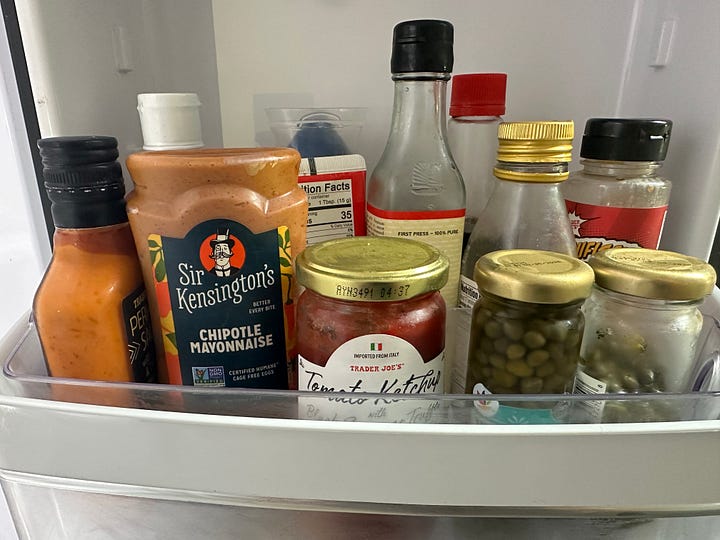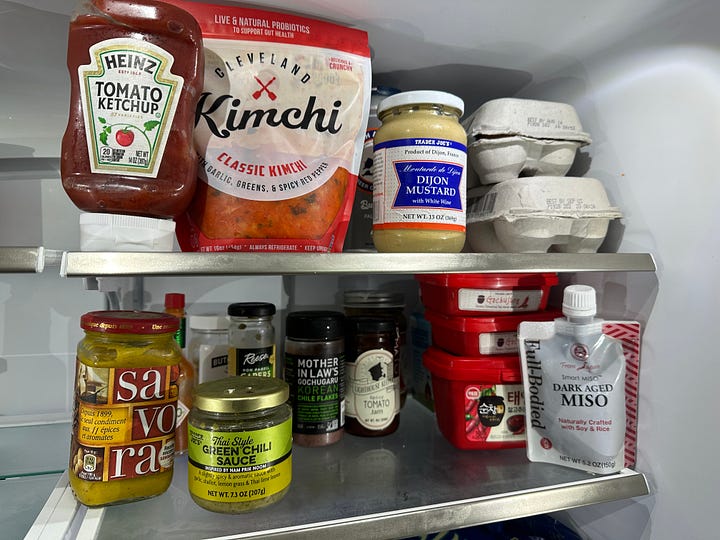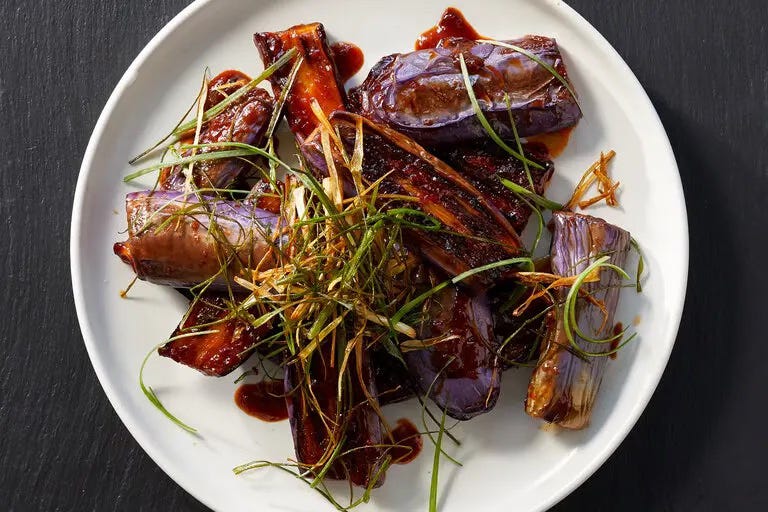What condiments are in your frig?
Eric Kim, the brilliant NYTimes food writer/recipe developer asked this provocative question at the Martha's Vineyard Book Festival.
Seriously, what condiments are lurking in your frig? And what’s the story behind them?
Why do I ask? Because…. your condiments tell the story of you! Share your condiment list and share your story.
A back-story.
I recently attended the 2025 Martha’s Vineyard Book Festival, a glorious bi-annual event featuring 30 fascinating authors from the world of food, fiction, politics, history, sociology, anthropology. National Geographic just proclaimed it one of the 7 best book festivals around the world.
Ligaya Mishan, the New York Times food critic, moderated a food panel, weirdly titled “Eating Our Stories.” Fortunately, the panel was NOT about how we are consuming our own stories but how the foods we eat tell a story about us.
The panelists, Eric Kim, Steven Satterfield, Julia Blanter, and Jessica Harris, told their own stories about food and what it means to them. As they talked, I realized how food is a story of place - the place we come from, the places we’ve visited, the places we want to go.
Eric Kim is a Korean American (intentionally unhyphenated) recipe developer at the NYTimes. Steven Satterfield is a James Beard Award winning chef and co owner of Atlanta’s Miller Union restaurant. Jessica Harris is a culinary historian, professor, and the author of 17 food-related books. Julia Blanter wrote a cookbook devoted to the Martha’s Vineyard diverse and intentional food scene.
Eric talked about how our refrigerators and pantries tell the story of how we eat now and how we have eaten over time. And my, how our eating habits have evolved. He was the first to ask: what condiments are in your frig?
Here’s my condiment story.
My daughter once told me my frig was overflowing with condiments and noticeably void of anything edible, much less nourishing. I hate to admit it – she was not wrong. When I look in my frig, I see a LOT of condiments; there are others I can’t see because they are hidden behind taller containers.


And it hits me. These condiments are a testament to my culinary hopes and dreams, long-lasting tokens of the foods I want to cook and the foods I imagine myself cooking someday. They manifest my current flavor preferences, my interest in various culinary traditions, and nostalgia for my upbringing.
My annotated condiment list:
· Unopened jar of Heinz ketchup. Because it feels unAmerican not to have ketchup in the frig, even if I don’t use it.
· Hellman’s mayonnaise. Important for slathering on swordfish steaks before grilling.
· 3 containers of gochujang, a Korean red pepper paste, thanks to Eric Kim’s recipes. Gochujang has added so much Unami richness to my life. The Koreans know how to meld sweet, sour, salty, bitter, spicy flavors into complex addictive flavors. Try Eric’s eggplant recipe below to see what i’m talking about.
· Soy sauce. Because it’s a basic.
· Fish sauce. For occasional fried rice and vegetable dinners.
· Dark and White Miso. Not exactly sure why I have these but I assume I will use them some day. And Yes, I am deep into an Asian cooking phase.
· Not 1 but 2 kinds of kimchi. Learning how to use it.
· 4 jars of mustard. 2 kinds of French Dijon, a honey mustard, and an aioli mustard. So many recipes call for mustard, but really do I need so much mustard?
· Verjuice. Vinegar made from unripened grapes. It’s got a bright, crisp acidity and fruity flavors. Use it in cooking or in mixed drinks. Softer tasting than regular vinegar.
· Capers. 3 jars. 1 unopened, 1 half used, 1 almost all gone. Love capers. They bring small bursts of tangy brininess to whatever I put them in.
· 3 kinds of hot sauce. Siracchi, tobacco, chipotle mayo. Because I’m a spicey kind of gal.
· Horseradish. For the Bloody Mary’s I never make or drink. But I like the thought of them.
So what stories do my condiments bring to the table (so to speak)
In too many ways, the condiments capture my story. I’m a wanna-be cook going through an Asian phase. I’m definitely susceptible to recommendations from cookbook writers I read on line (why else would I have Verjus). And I can’t get away from mustard and ketchup because they go on the hamburgers and hot dogs I never eat but think I might some day.
Now I want to ask you - and Eric Kim! - what condiments are in your frig? And why? Share your condiments! Share your story!
Here is Eric Kim’s brilliant eggplant with gochujang recipe, from the New York Times. And there’s a video too.
It’s simple to make and addictively delicious. You can order gochujang from Amazon. I also bought some at Trader Joe’s.
The recipe.
Step 1
Place 1 pound Asian eggplant (about 3 large; preferably Korean, or Chinese or Japanese), halved lengthwise and cut into 4- to 5-inch segments in a colander set inside a large bowl or the sink. Sprinkle with the salt, toss to combine and let sit for 30 minutes to remove excess moisture.
Step 2
In a small bowl, add:
· 1 teaspoon kosher salt
· 2 tablespoons gochujang
· 1 tablespoon soy sauce
· 2 packed teaspoons dark brown sugar
· 1 teaspoon toasted sesame oil
· 2 garlic cloves, finely grated
Whisk to combine. (Note to readers: this sauce is addictive. I have been putting it on other veggies, pasta, scrambled eggs, even grilled cheese sandwiches.)
Step 3
Put 1/2 c. olive oil and the white parts 4 scallions, sliced thinly lengthwise in a skillet. Turn the heat to medium and fry the scallions, stirring often, until crispy and evenly browned, about 8 minutes.
Reserve a small handful of raw scallion greens for garnish, then fry the remaining scallion greens in the oil until crispy and lightly browned, 3 to 5 minutes. Transfer fried scallion greens onto a paper towel.
Step 5
Remove the skillet from the heat and carefully pour the hot scallion oil into a glass container or measuring cup.
Step 6
After the 30 minutes of salting, dry the eggplant segments with a paper towel. Place the skillet over medium-high heat and add 2 tablespoons of the reserved scallion oil.
Step 7
When the oil starts to shimmer and you see a wisp of smoke, add half the eggplant, cut sides down, and fry until browned and starting to soften, 2 to 3 minutes. Flip once and cook another minute on the other side. Transfer to a plate, add 2 more tablespoons of scallion oil back to the pan, and repeat to fry the second batch of eggplants. (If you are lucky enough to have any scallion oil left, use it to fry eggs or to dress a salad.)
Step 8
Finally, sauce the eggplants: Add the first batch of eggplants back to the pan alongside the second batch. Reduce the heat to medium-low and pour the reserved gochujang sauce over the eggplants. Toss until evenly coated and the gochujang starts to caramelize, about 1 minute.
Step 9
Plate the eggplants on a large platter and garnish with the fried scallions and the reserved raw scallion greens. Serve immediately. To store for later, transfer to a resealable container and keep in the refrigerator for 3 to 5 days. This dish tastes great cold, straight out of the fridge, or at room temperature.



I love this, Anne. It is so much fun to do this task. Umami toppings that I put on fish before cooking. Kali curry that is simply an add-to-a-good-curry dish. 7 different kinds of mustard because you never have enough. Ketchup, A1 sauce, mayonnaise, and horseradish sauce, refrigerator staples. Rice wine vinegar and roasted sesame oil that I use in salad dressings. Tamari because John puts it on everything. Red curry paste for my curry dishes. Bitters for when my kids come by for their bourbon cocktails. That is my story.
Just printed out Kim's recipe: cannot wait! Fun question he asked: I'm taking a look soon, but the same can be asked of the spices I've collected. Incredible diversity and such a change from just a few years ago. Thanks, Anita